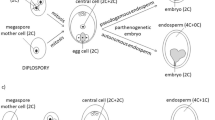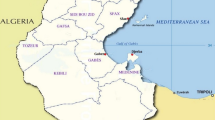Abstract
The genetic relationships between and within Hibiscus syriacus, Hibiscus sinosyriacus and Hibiscus paramutabilis, three winter hardy Hibiscus species native to China, were analysed by the amplified fragment length polymorphisms (AFLP) technique and by morphological evaluation of flower and leaf characteristics. Both methods clearly discriminated between the three species. H. sinosyriacus was classified as an intermediate form between H. paramutabilis and H. syriacus; however, it showed a higher similarity to H. paramutabilis. The different H. syriacus cultivars could be identified by AFLP analysis, while also leaf indices clustered the different cultivars in small groups. Flow cytometry showed that both triploid and tetraploid cultivars occur in the H. syriacus assortment. In general triploid cultivars had larger flowers compared to diploid cultivars.
Similar content being viewed by others
References
Ajmone Marsan, P., P. Castiglioni, F. Fusari, M. Kuiper & M. Motto, 1998. Genetic diversity and its relationship to hybrid performance in maize as revealed by RFLP and AFLP markers. Theor. Appl. Genet. 96: 219–227.
Bailey, L.H., 1950. The Standard Cyclopedia of Horticulture. Macmillan, New York, NY, USA.
Bates, D.M., 1965. Notes on the cultivated Malvaceae. 1. Hibiscus. Baileya 13: 57–130.
Bean, W.J., 1973. Trees and Shrubs Hardy in the British Isles, 8th ed., revised volume II. John Murray, London, UK.
Beers, L. & J. Howie, 1992. Growing Hibiscus. Kangaroo Press, Kenthurst, UK.
De Riek, J., J. Dendauw, M. Mertens, M. De Loose, J. Heursel & E. Van Bockstaele, 1999. Validation of criteria for the selection of AFLP markers to assess the genetic variation of a breeders' collection of evergreen azaleas. Theor. Appl. Genet. 99: 1155–1165.
De Riek, J., M. Mertens, J. Dendauw, J. Heursel, E. Van Bockstaele & M. De Loose, 2000a. The use of fluorescent AFLP to assess genetic conformity of a breeders collection of R. simsii hybrids. Acta Hortic. 508: 99–104.
De Riek, J., M. Mertens, J. Dendauw, J. Heursel, E. Van Bockstaele & M. De Loose, 2000b. Azalea (Rhododendron simsii hybrids) germplasm from China assessed by means of fluorescent AFLP. Acta Hortic. (in press).
Doyle, J. & J.L. Doyle, 1987. Genomic plant DNA preparation from fresh tissue: CTAB method. Phytochem. Bull. 19: 11.
Egolf, D.R., 1970. Hibiscus syriacus 'Diana' a new cultivar (Malvaceae). Baileya 17: 75–78.
Egolf, D.R., 1981. Meet 'Helene' a new Hibiscus syriacus. Am. Nurseryman 154: 11–67.
Galbraight, D.W., K.R. Harkins, J.M. Maddox, N.M. Ayres, D.P. Sharma & E. Firozabady, 1983. Rapid flow cytometric analysis of the cell cycle in intact plant tissues. Science 220: 1049–1051.
Hill, M., H. Witsenboer, M. Zabeau, P. Vos, R. Kesseli & R. Michelmore, 1996. PCR-based fingerprinting using AFLPs as a tool for studying genetic relationships in Lactuca spp. Theor. Appl. Genet. 93: 1202–1210.
Hillier, 1991. The Hillier Manual of Trees and Shrubs. Redwood Press, Melksham, UK.
Hongtrakul, V., G.M. Huestis & S.J. Knapp, 1997. Amplified fragment length polymorphisms as a tool for DNA fingerprinting sunflower germplasm: genetic diversity among inbred lines. Theor. Appl. Genet. 95: 400–407.
Kim, J.H. & K.C. Lee, 1991. Studies on the flower color variation in Hibiscus syriacus L. I. Spectral properties of fresh petals and flower color classification. J. Kor. Soc. Hortic. Sci. 32: 103–111.
Krüssmann, G., 1962. Handbuch der Laubgehölze. Band 2. Paul Parey, Berlin, Germany.
Legendre, P. & A. Vaudor, 1991. The R package: multidimensional analysis, spatial analysis. Département de Sciences Biologiques, Université de Montréal, 142 pp.
Maughan, P.J., M.A. Saghai Maroof, G.R. Buss & G.M. Huestis, 1996. Amplified fragment length polymorphism (AFLP) in soybean: species diversity, inheritance and near-isogenic line analysis. Theor. Appl. Genet. 93: 392–401.
Niimoto, D.H., 1966. Chromosome numbers of some Hibiscus species and other Malvaceae. Baileya 14: 29–34.
Paul, S., F.N. Wachira, W. Powell & R. Waugh, 1997. Diversity and genetic differentiation among populations of Indian and Kenyan tea (Camellia sinensis (L.) O. Kuntze) revealed by AFLP markers. Theor. Appl. Genet. 94: 255–263.
Perkin-Elmer, 1995. AFLPTM Plant Mapping Kit: Protocol.
Shim, K.K., K.H. Kim & Y.M. Ha, 1993. Characteristics of triploid cultivars 'Diana' and 'Helene' in Hibiscus syriacus L. J. Kor. Soc. Hortic. Sci. 34: 54–67.
Skovsted, A., 1941. Chromosome numbers in the Malvaceae II. Comptes rendus des travaux du laboratoire Carlberg, Série Physiologique 23: 195–242.
Van de Laar, H.J., 1997. Hibiscus syriacus. Dendroflora 34: 43–60.
Van Huylenbroeck, J.M., W. Istas & J. Haegeman, 1998. Hibiscus syriacus sortiment doorgelicht. Verbondsnieuws Belgische Sierteelt 42(6): 27–29.
Vos, P., R. Hogers, M. Bleeker, M. Reijans, T. van de Lee, M. Hornes, A. Fijters, J. Pot, J. Peleman, M. Kuiper & M. Zabeau, 1995. AFLPTM: a new technique for DNA fingerprinting. Nucleic Acids Res. 21: 4407–4414.
Yu, T.Y. & D.Y. Yeam, 1972. A survey on flower types and colors in Hibiscus syriacus L. J. Kor. Soc. Hortic. Sci. 11: 55–61.
Author information
Authors and Affiliations
Rights and permissions
About this article
Cite this article
Van Huylenbroeck, J., De Riek, J. & De Loose, M. Genetic relationships among Hibiscus syriacus, Hibiscus sinosyriacus and Hibiscus paramutabilis revealed by AFLP, morphology and ploidy analysis. Genetic Resources and Crop Evolution 47, 335–343 (2000). https://doi.org/10.1023/A:1008750929836
Issue Date:
DOI: https://doi.org/10.1023/A:1008750929836




